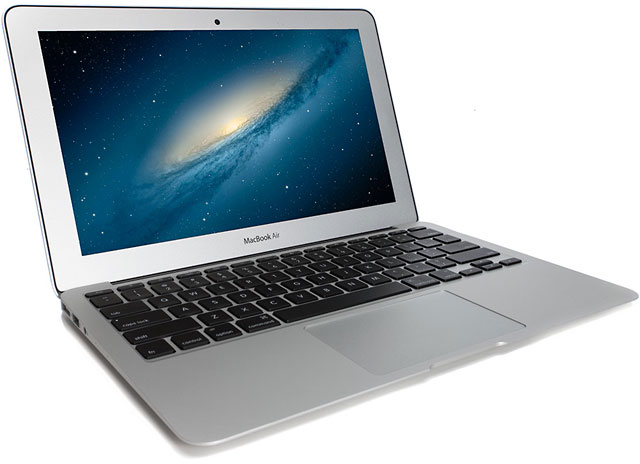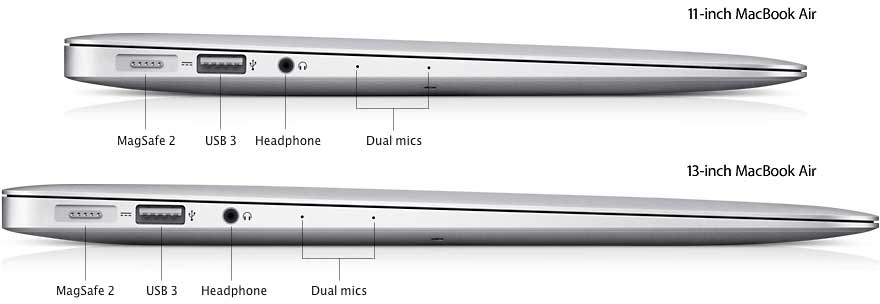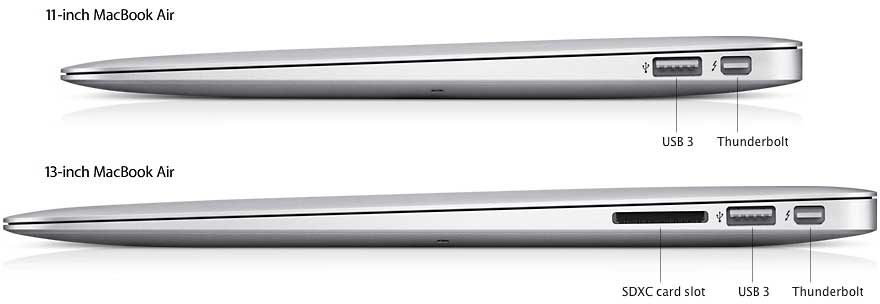The big breakthrough for the Mid 2013 MacBook Air (MBA) is improved battery life. The 11″ model is now rated at 9 hours in the field, a huge jump from the 2012 model. And if you don’t use your MBA regularly, it has 30 days of standby power.
Built around 4th-generation low-power Intel Core i5 and i7 processors, the Mid 2013 MBA has Intel HD Graphics 5000, a significant step forward from 4000 with up to 40% faster graphics. And with Power Nap, the 2013 MacBook Air can receive email even when it’s asleep.
You may wonder how performance compares with last year’s MacBook Air. The new 1.3 GHz i5 outscores the 1.7 GHz i5 on Geekbench 6593 to 6126, and the new 1.7 GHz i7 bests last year’s 2.0 GHz i7 8104 to 7512.
On the WiFi front, these are the first MBAs with 802.11ac wireless support, which is up to 3x as fast as 802.11n and also offers extended range.
Apple hasn’t forgotten performance – the SSDs used this year are up to 40% faster than those in last year’s MBA and about 9x as fast as a typical 5400 rpm notebook hard drive.
Like the Mid 2012 MacBook Air, the Mid 2013 version includes built-in USB 3 support. USB 3 is over 10x as fast as USB 2.0 and has half the bandwidth of Thunderbolt, which is also included. (No Thunderbolt 2 for the MBA; that’s still reserved for the 2013 Mac Pro, due later this year.) Apple uses the same port for USB 2.0 and 3 to simplify things, while the standard in the PC world is separate ports for each protocol.
There’s also a 720p FaceTime HD webcam, and the 2013 MBA now includes two microphones for improved sound pickup. The native screen resolution remains 1366 x 768. And the keyboard is backlit so you can see the keys in even the darkest setting.
Apple offers a number of build-to-order options for the better model: Upgrade to a 1.7 GHz Core i7 CPU for $150, choose a 512 GB SSD for an extra $800. You can double system memory to 8 GB for $100 more on any model.
A few things are missing: The MBA has no built-in optical drive, but you can add an external USB 2.0 SuperDrive for $79. There is no FireWire port, but that’s far less necessary with USB 3 and Thunderbolt. And there’s no built-in ethernet port; if you need ethernet, Apple sells a USB ethernet adapter for $29.
The MacBook Air has an 18-bit glossy display (not the 24 bits you might expect). Like the iPad and iPhone, it does not have an easily replaceable battery. Cost to have Apple replace the 37 Watt-hour battery out of warranty is $129.
Closed Lid Mode: All Intel ‘Books support “lid closed” (or clamshell) mode, which leaves the built-in display off and dedicates all video RAM to an external display. To used closed lid mode, your ‘Book must be plugged into the AC adapter and connected to an external display and a USB or Bluetooth mouse and keyboard (you might also want to consider external speakers). Power up your ‘Book until the desktop appears on the external display and then close the lid. Your ‘Book will go to sleep, but you can wake it by moving the mouse or using the keyboard. The built-in display will remain off, and the external monitor will become your only display. Since all video RAM is now dedicated to the external monitor, you may have more colors available at higher resolutions. The MacBook Air is designed to run safely in closed lid mode, but if yours runs hot (perhaps due to overclocking or high ambient temperatures), you may want to open the lid when in closed lid mode: The screen will remain off and the computer will more readily vent heat from the CPU.
To resume use of the internal display, you need to disconnect the external display, put the computer to sleep, and then open the lid. This will wake up your ‘Book and restore use of the built-in display.
Details
- introduced 2013.06.11 at US$999 (4 GB RAM, 128 GB SSD) and US$1,199 (4 GB RAM, 256 GB SSD), 2.0 GHz i7 $150 build-to-order option
- Identifier: MacBookAir6,1
- Model no.: A1465
- Part no.: MD7111, MD712
Mac OS
- requires Mac OS X 10.8 or later
- Mac OS X 10.8 Mountain Lion compatibility
- AirPlay Mirroring is supported.
- AirDrop is supported.
- Power Nap is supported.
Core System
- CPU: 1.3 GHz Intel Core i5 (Turbo Boost to 2.6 GHz), 1.7 GHz i7 option (3.3 GHz Turbo Boost)
- Level 2 cache: 3 MB in i5, 4 MB in i7
- Bus: 1066 MHz
- RAM: 4 GB, 8 GB $100 build-to-order option
- Performance (1.3/1.7 GHz):
- 64-bit Geekbench: 6544/8139
- Speedmark 7:
Video
- Graphics: Intel HD Graphics 5000, supports extended desktop.
- VRAM: uses up to 1.5 GB of system memory
- Video out: Thunderbolt (to 2560 x 1600 resolution)
- display: 11.6″ glossy 1366 x 768 135 ppi color active matrix
- supports 1366 x 768, 1344 x 756, and 1280 x 720 pixels at 16:9 aspect ratio; 1152 x 720 and 1024 x 640 at 16:10 aspect ratio; 1024 x 768 and 800 x 600 at 4:3 aspect ratio
- allows mirroring to external display and extended desktop mode
Drives
- Hard drive: 128/256 GB solid state drive standard, 512 GB $300 option on 256 GB model
- SSD: 6 Gb/s SATA
- SuperDrive: optional external USB 2.0 drive, requires high power USB port (only compatible with MacBook Air)
Expansion
- Thunderbolt: 1 port
- USB: 2 USB 3 ports
- FireWire: via Thunderbolt adapter
- Ethernet: via Thunderbolt adapter
- WiFi: 802.11ac AirPort Extreme built in
- Modem: No longer offered by Apple
- Bluetooth: BT 4.0 built in
- ExpressCard/34 slots: none
- SD Card slot: none
- expansions bays: none
- IR port: none
- webcam: FaceTime 720p HD camera
Power
- battery: 38 Watt-hour, 9 hours of wireless productivity
- AC adapter: 45W MagSafe 2
Physical
- size: 7.56 x 11.8 x 0.11-0.68″ (192 x 300 x 3.0-17 mm)
- Weight: 2.38 pounds (1.08 kg)
Online Resources








